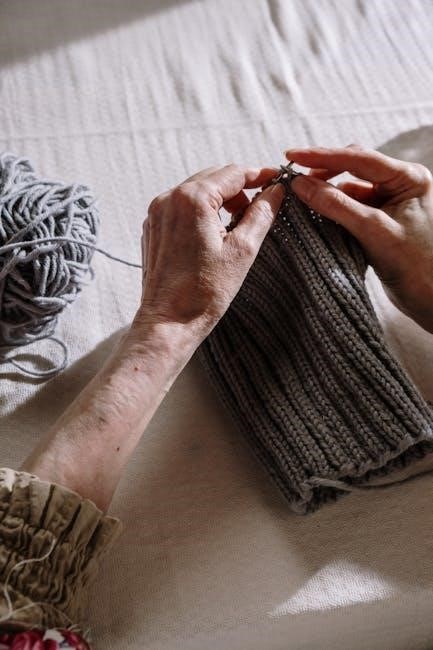Welcome to our guide on making delicious oven-ready lasagna! This convenient dish offers a classic Italian meal with minimal prep. Simply layer sauce, cheese, and pre-made noodles, then bake at 375°F for 30-45 minutes. Perfect for a hearty, satisfying dinner.
What is Oven-Ready Lasagna
Oven-ready lasagna refers to a convenient and time-saving version of traditional lasagna. It uses pre-made lasagna noodles that do not require boiling before baking. These noodles are specifically designed to absorb moisture from the sauce and cheese during the baking process, ensuring they cook perfectly in the oven. This eliminates the need for pre-cooking, making the preparation faster and more straightforward. Oven-ready lasagna is ideal for busy home cooks who want to enjoy a classic Italian dish without the extra step of boiling pasta. The noodles are typically layered directly in the baking dish with sauce, cheese, and other desired fillings, then baked in the oven until tender and bubbly. This method maintains the authentic taste and texture of traditional lasagna while offering a modern, hassle-free approach to preparing this beloved meal.

Why Use Oven-Ready Lasagna
Using oven-ready lasagna offers numerous advantages that make it a preferred choice for home cooks. First and foremost, it saves time by eliminating the need to boil the noodles beforehand. This convenience is especially beneficial for those with busy schedules, as it streamlines the preparation process. Additionally, oven-ready lasagna reduces the risk of overcooking the noodles, which can happen when boiling traditional pasta. The pre-made noodles are designed to absorb the perfect amount of moisture from the sauce and cheese during baking, resulting in a perfectly cooked dish every time. Furthermore, oven-ready lasagna minimizes kitchen cleanup, as there’s no need for a large pot of boiling water. This method also allows for greater consistency in texture and flavor, ensuring a delicious and satisfying meal without extra effort. Overall, oven-ready lasagna is a practical and efficient option for creating a hearty, homemade lasagna with minimal hassle.
Ingredients Needed

- Ground beef or turkey sausage for the meat layer
- Onion and garlic for added flavor
- Spaghetti sauce for moisture and taste
- Ricotta cheese for creaminess
- Mozzarella and Parmesan cheese for richness
- Oven-ready lasagna noodles
- Olive oil for browning
- Salt, pepper, and herbs like oregano or basil
Main Components
The foundation of oven-ready lasagna lies in its three primary layers: sauce, cheese, and pasta. The sauce provides moisture and flavor, while the cheese adds creaminess and richness. Oven-ready lasagna noodles are specifically designed to cook directly in the oven without boiling, saving time and effort. These noodles absorb the flavors of the sauce and cheese during baking, creating a tender and cohesive texture. The sauce layer typically consists of a pre-made or homemade tomato-based sauce, seasoned with herbs like oregano and basil. For the cheese mixture, ricotta is often combined with mozzarella and Parmesan, offering a creamy base that melts beautifully during baking. By layering these components in a baking dish, you create a dish that is both satisfying and easy to prepare, perfect for a weeknight meal or special occasion. This method ensures a delicious, stress-free cooking experience with minimal preparation time.
Additional Ingredients
While oven-ready lasagna can be made with just the basics, adding extra ingredients can enhance its flavor and texture. Ground beef or turkey sausage, browned with garlic and onion, adds a hearty, savory element to the dish. Fresh or dried herbs like oregano, basil, and Italian seasoning can deepen the sauce’s flavor profile. For extra creaminess, consider incorporating sour cream or Greek yogurt into the ricotta mixture. Spinach, mushrooms, or bell peppers can add freshness and variety to the layers. Some recipes also include a sprinkle of Parmesan cheese for an extra burst of flavor. These additions allow you to customize the lasagna to your taste preferences, making it a versatile meal option. By incorporating these ingredients, you can create a dish that is both satisfying and flavorful, ensuring a delightful experience for everyone at the table. This flexibility makes oven-ready lasagna a great choice for experimenting with different flavors and dietary preferences.
Preparation Steps
Preparation begins with preheating the oven to 375°F. Lightly grease the baking dish to prevent sticking. Brown ground beef with garlic and seasonings. Prepare the cheese mixture with ricotta, mozzarella, and Parmesan. Layer sauce, noodles, and cheese, finishing with a generous cheese topping.

Preheat the Oven
Preheating the oven is the first and most crucial step in preparing oven-ready lasagna; Set your oven to 375°F (190°C) and allow it to preheat for at least 15-20 minutes to ensure even cooking. Place the oven rack in the middle position to promote consistent heat distribution. While the oven preheats, you can begin preparing the other components of the dish, such as browning the ground beef or mixing the cheese blend. It’s important to ensure the oven has reached the correct temperature before placing the lasagna inside, as this will help the noodles cook properly and prevent the bottom layer from burning. If you’re using a convection oven, you may need to adjust the temperature slightly, typically reducing it by 25°F (15°C) for convection settings. Once the oven is ready, carefully place the prepared lasagna in the baking dish on the middle rack and proceed with the next steps. Proper preheating ensures a delicious, evenly cooked meal every time.
Prepare the Baking Dish
Preparing the baking dish is a simple yet essential step in making oven-ready lasagna. Start by selecting a 9×13-inch baking dish, as this size works best for layering the ingredients evenly. Lightly grease the bottom and sides of the dish with non-stick cooking spray or a small amount of olive oil to prevent the lasagna from sticking during baking. This step ensures easy serving and cleanup. Next, spread a thin layer of marinara or tomato sauce across the bottom of the dish. This not only adds flavor but also helps keep the oven-ready noodles moist and prevents them from drying out during baking. If you’ve browned ground beef or sausage, you can mix it into the sauce for extra flavor; Avoid adding too much sauce, as the cheese and other layers will contribute to the dish’s moisture. Once the dish is prepared, it’s ready to accept the first layer of noodles. Proper preparation of the baking dish sets the foundation for a perfectly cooked lasagna. For easier cleanup, consider lining the dish with parchment paper, though this is optional; Ensuring the dish is well-prepared will result in a delicious, evenly cooked meal.
Brown the Ground Beef
Browning the ground beef is a crucial step that adds rich flavor to your oven-ready lasagna. Start by heating a large skillet over medium-high heat and add a tablespoon of olive oil to prevent sticking. Once the skillet is hot, add the ground beef and break it apart with a spatula into small pieces. Cook until the meat is fully browned, stirring occasionally to ensure even cooking. This process typically takes about 5-7 minutes. As the beef cooks, add minced garlic and onion for extra flavor, sautéing until translucent. Season the mixture with salt, pepper, and your choice of herbs like oregano or basil. If using, stir in tomato paste or a splash of red wine for added depth. After browning, drain excess fat using a paper towel or a slotted spoon to avoid a greasy lasagna. Finally, mix in your marinara or tomato sauce, letting it simmer for a few minutes to combine flavors. This step ensures the beef is flavorful and ready to layer into your lasagna. Avoid overcrowding the skillet, as this can prevent proper browning. For a leaner option, use ground turkey or plant-based alternatives. Properly browning the beef enhances the overall taste of the dish.
Prepare the Cheese Mixture
The cheese mixture is a key component of oven-ready lasagna, adding creaminess and flavor to each layer. In a large mixing bowl, combine 16 ounces of ricotta cheese with 2 cups of shredded mozzarella and ½ cup of grated Parmesan. Mix these ingredients until well blended. Add a pinch of salt and pepper to taste, along with optional herbs like basil or oregano for extra flavor. For a richer texture, incorporate 1-2 beaten eggs into the mixture, ensuring they are fully incorporated. Stir in chopped fresh parsley or other herbs if desired. Avoid overmixing, as this can make the cheese tough. This mixture serves as the creamy base for your lasagna layers. Some recipes also suggest adding garlic powder or Italian seasoning for added depth. Ensure the cheese is at room temperature for easier mixing. This step is foundational for a smooth, even layer in your lasagna. Properly combining the cheeses ensures a balanced flavor and texture. For a lighter version, you can substitute part of the ricotta with cottage cheese. This mixture is ready to be layered with the meat sauce and noodles. Always use fresh, high-quality cheeses for the best results. The cheese mixture is a simple yet essential part of creating a delicious oven-ready lasagna. Let it sit for a few minutes before assembling to allow flavors to meld. This ensures a cohesive and tasty final dish.
Layer the Lasagna

Layering is a crucial step in creating a delicious oven-ready lasagna. Start by spreading a thin, even layer of marinara sauce at the bottom of the prepared baking dish to prevent the noodles from sticking. Arrange a layer of oven-ready lasagna noodles on top of the sauce, ensuring they are evenly spaced and do not overlap. Next, spread half of the cheese mixture over the noodles, followed by half of the browned ground beef or other toppings of your choice, such as sautéed spinach or diced vegetables. Sprinkle with half of the shredded mozzarella and a portion of grated Parmesan cheese. Repeat this process, starting with another layer of noodles, then the remaining cheese mixture, the remaining ground beef or toppings, and finally the remaining mozzarella and Parmesan. For an extra cheesy top, add additional mozzarella and Parmesan. To ensure even cooking, avoid overlapping noodles and spread each layer smoothly. This step-by-step layering ensures a balanced and flavorful dish. Always finish with a generous layer of cheese on top for a golden, bubbly finish. Proper layering is key to achieving the perfect texture and taste in your oven-ready lasagna. Take your time to assemble each layer carefully for the best results.
Add the Cheese Topping

The final step before baking is adding the cheese topping, which gives the lasagna its golden, bubbly finish. Sprinkle a generous amount of shredded mozzarella cheese evenly over the top layer of the lasagna. For extra flavor, mix in some grated Parmesan cheese with the mozzarella. If using ricotta cheese, you can also incorporate it into this topping by spreading a thin layer over the lasagna before adding the mozzarella and Parmesan. Ensure the cheese covers the entire surface to create a uniform texture. To enhance the flavor, you can add a pinch of dried oregano or basil to the cheese mixture. For a crispy, caramelized crust, sprinkle a small amount of grated Parmesan on top of the mozzarella. Avoid overloading the dish with too much cheese, as this can make it overly rich. Once the cheese topping is in place, your lasagna is ready to be baked. This step ensures a creamy, golden, and deliciously satisfying finish to your oven-ready lasagna.

Baking Instructions
Preheat your oven to 375°F (190°C). Cover the lasagna with foil and bake for 30-45 minutes. Remove the foil for the last 10-15 minutes to allow the cheese to brown. Let it rest for 10 minutes before serving.
Cover with Foil
To ensure even cooking and prevent the top layer from drying out, cover the lasagna pan with aluminum foil before baking. Tent the foil slightly to avoid direct contact with the cheese or sauce. This step promotes moisture retention and helps the noodles cook evenly. Use heavy-duty foil for better durability. Covering also prevents cheese from browning too quickly; Remove the foil during the last 10-15 minutes of baking to allow the top to crisp up slightly. Always handle hot foil with oven mitts or tongs to avoid burns. Covering is essential for the first phase of baking, as it traps steam and heat, ensuring the lasagna cooks thoroughly. For extra protection, you can lightly spray the underside of the foil with cooking spray to prevent sticking. Once covered, place the dish in the preheated oven and proceed with the baking time as instructed. This method guarantees a perfectly cooked, moist, and flavorful lasagna every time.
Baking Time and Temperature
Bake the lasagna in a preheated oven at 375°F (190°C) for 30-45 minutes when covered with foil. For the first 25-30 minutes, keep it covered to allow the noodles to soften and the flavors to meld without drying out. After removing the foil, continue baking for an additional 10-15 minutes, or until the cheese is bubbly and golden brown. If using a lower temperature like 350°F (175°C), increase the baking time by about 10-15 minutes. Always ensure the internal temperature reaches 165°F (75°C) for food safety. Avoid overheating, as this can cause the cheese to burn or the noodles to become mushy. For a crisper top, increase the oven temperature to 400°F (200°C) during the last 5 minutes of baking. Let the lasagna rest for 10-15 minutes before serving to allow the layers to set. This ensures clean, even slices and a satisfying texture. Adjust baking time slightly if using different-sized dishes or layer configurations. Always use oven mitts to handle the hot dish safely. Proper baking time and temperature are crucial for achieving a perfectly cooked, cheesy lasagna.
Uncover and Finish

After baking the lasagna covered for the initial 25-30 minutes, carefully remove the foil to allow the top layer to brown and crisp up. Return the dish to the oven and bake for an additional 10-15 minutes, or until the cheese is bubbly and golden brown. Keep an eye on the lasagna to ensure the top doesn’t burn. Once the cheese is melted and slightly caramelized, remove the dish from the oven. Let it rest for 10-15 minutes before slicing and serving. This resting period allows the layers to set, making the lasagna easier to cut neatly. During this time, the internal temperature should reach 165°F (75°C) for food safety. To check, insert a knife or meat thermometer into the center of the dish. Avoid slicing too soon, as the hot cheese and sauce may cause the layers to shift. Once set, serve hot and enjoy the perfectly baked, cheesy lasagna!

Cooking Tips and Tricks
For the best results, ensure each layer of lasagna is evenly spread to maintain structure. Use high-quality ingredients like fresh ricotta and Parmesan for richer flavor. Add a layer of sauce or ricotta to prevent noodles from drying out. Avoid overbaking to keep the dish moist and cheesy.
Layering Tips
When layering your oven-ready lasagna, start with a thin layer of sauce at the bottom of the dish to prevent the noodles from sticking. Alternate between layers of sauce, cheese mixture, and lasagna sheets, ensuring each layer is evenly spread. To add extra flavor, mix ground beef or sausage into the sauce for a hearty twist. For the cheese mixture, combine ricotta, mozzarella, and Parmesan for a creamy texture. Avoid overlapping the lasagna sheets, as this can cause uneven cooking. Instead, fit them snugly side by side. If using additional ingredients like spinach or mushrooms, distribute them evenly throughout the layers. Finally, finish with a generous layer of cheese on top to create a golden, bubbly crust. By following these layering tips, you’ll achieve a perfectly balanced and delicious lasagna every time. Proper layering ensures each bite is packed with flavor, making your dish a family favorite.
Preventing Dryness

To prevent dryness in oven-ready lasagna, ensure each layer is well-coated with sauce or cheese mixture. Start by spreading a thin, even layer of sauce at the bottom of the dish to keep the noodles moist. Cover the dish with foil during the initial baking phase to retain moisture and heat. Remove the foil toward the end to allow the cheese to brown without drying out the lasagna. Using enough sauce and cheese is key, as they help keep the dish hydrated during baking. Additionally, avoid overbaking, as this can cause the noodles to become dry. If using lean ground meat, mix it with enough tomato sauce to maintain a saucy consistency. For extra moisture, you can add a splash of water or broth to the sauce before layering. Letting the lasagna rest for 10-15 minutes after baking also helps retain its moisture. By following these tips, you’ll achieve a rich, flavorful, and perfectly moist oven-ready lasagna every time.























































